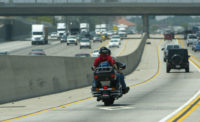Good employees are hard to find. Keeping them safe and productive is just as hard. That is why many savvy employers are now investing in enhanced ergonomics to minimize workplace reportable strain injuries. A safe workplace is a recruiting and retention differentiator.
U.S. Department of Labor statistics show that women and older adults make up a significantly larger part of the manufacturing workforce than they did just a decade ago.
Employees come in all shapes, sizes, strengths, and ages. That isn’t likely to change. Adding automation and designing ergonomically optimized material handling carts– means it is easier for all employees to transport materials and finished goods in the best position and with the least push force effort for assembly and loading. That is true efficiency.
Whether moving parts to the dock or product down an assembly line, lower push forces mean that employees can move materials quickly with less wear on their bodies and greater productivity.
Tip #1: Design material-handling equipment to minimize push forces
Start by looking at wheel size. Taller and narrower wheels create less resistance and are easier to get rolling. The taller profile helps overcome cracks, dips, and other floor imperfections, as well.
Wheel material is also crucial. Harder polyurethane materials, as an example, can significantly improve transportability and durability, as softer materials require more initial force to get the cart rolling. Softer materials also tend to wear faster, causing further issues to movement.
Harder wheel materials, however, can generate more noise in the workplace and limit the shock-absorbing ability of softer materials. Shock-absorbing springs and bearings can help alleviate the noise factor.
Wheel bearings are the third essential element for low-energy movement. Good, well-maintained wheel bearing can significantly reduce the initial force required to move a cart, and the amount of energy required to keep the cart moving.
Wheel design can also impact push force and load capacity. Products such as Twergo reduce push forces by up to 55%, keeping associates safer while allowing higher weight loads to by moved. Looking for third party endorsements, such as those by ergonomic specialists Ergonauts, can confirm the exact impact of enhanced casters.
Tip #2: Design for easy maneuverability and secure braking
Too often, operations lose sight of the need for easy manual maneuvering and braking. Those two tasks require different muscles and energy than straight line movement. Wheel size and material once again play a big factor here. This is an opportunity to look at the right combination of fixed and swivel casters, or tandem wheels, to help locate materials in the ideal location for assembly or loading.
On a related note, no one wants to deal with rollback. Getting the material to the precise location should be the end of the movement. Secure stopping and braking to avoid roll should be addressed in the design.
Tip #3: Seek engineering expertise from cart or caster-wheel supplier
Do-it-yourself operations should be cautious. The flip side to changing the wheel profile, wheel material, and bearing type is the physical limitations that the profile and materials might impose on the cart’s carrying capability. The goal should always be for the cart to handle all load requirements – including shock loads — safely and securely. Then work can be done to lower the push/pull force required for the operation.
Tip #4: For heavy loads, consider motorized casters
In situations involving extremely heavy components and finished goods movement, motorized casters are gaining popularity for two key benefits. A motorized caster configuration can eliminate the need for multiple associates to push a cart, increasing productivity. Also, motorized casters reduce the levels of physical exertion and noise creation, enhancing worker safety and satisfaction.
Major caster manufacturers have in-field technicians to help determine the optimal solution for your exact challenge. By understanding your facilities environment, materials and load sizes to be moved, load speeds and the other trade-offs, these techs and their engineering teams can address your exact needs. A properly specified caster will deliver significant benefits over a sub-optimal stock caster.




